Human Development Exam Review
1/121
There's no tags or description
Looks like no tags are added yet.
Name | Mastery | Learn | Test | Matching | Spaced |
|---|
No study sessions yet.
122 Terms
Anthropology
the study of humanity. It works to understand human development through what is considered a holistic approach concerned with different dimensions of humanity.
Psychology
the study of the human mind and behaviour. It focuses on the study of the mind, how it works and how it affects behaviour
Sociology
the study of human relations and societies. It focuses on a variety of different factors within society from religion, race, culture, and social change.
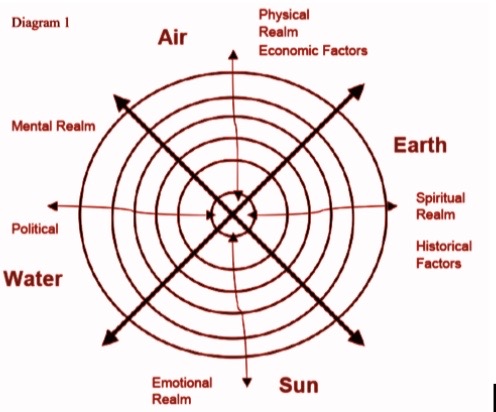
Indigenous Wholistic Theory
theory is a whole (ecological, cyclical and relational. the circle plays an important role in Indigenous ideology
the medicine wheel: illustrates the interconnectedness of self, individual, family community, nation, society and creation
indigenous ideology suggests that development is closely linked to all facets and connects the circle as an image of development
“wholeness” we are all related
Nurture
Human growth and development is primarily influenced and dependent on one’s experiences and their environment
Ex. Experiences faced impact one’s biology and environment
Nature
Humans grow in an orderly way and their development and traits are influenced primarily by “nature” or their genetics.
Ex. Genes, inherited traits
Continuity
Growth is gradual, and occurs over years. Not something that simply happens but is rather smooth
Ex. a child saying their first word is surprising and seems abrupt, it is actually the result of practice and growth over weeks.
Discontinuity
Development happens through stages or a sequence. Each stage has 1 task or challenge (or multiple).
Ex.insect → caterpillar → chrysalis → butterfly If a stage is missed, the insect won’t become a butterfly
Stability
Developmentalists who emphasize ______ believe that our personality and traits will remain the same.
Ex. if a child does not grow up in a warm, nurturing and loving environment, their development will never be optimal
Change
Developmentalists who emphasize change believe that we are malleable and capable of change.
Ex. Positive relationships are just as important during infancy as they are in adolescence and adulthood.
Universal
One developmental process that everyone experiences
Ex. Standard developmental process. Most major aspects to human life with regards to psychology and human behaviour do work in this way and are universal.
Context Specific
Developmental process is inextricably linked within the context that occurs
Ex. culture, history, religion, ethnicity, discrimination, etc.
Lifespan perspective
This perspective emphasizes developmental changes throughout adulthood as well as during childhood.
Normative age-graded influences
Events that are strongly related to age and therefore fairly predictable in when they occur and how long they might last:
Ex. most individuals walk shortly after their 1st birthday or going through around puberty from ages 12-14 (biological/physical)
Ex. Social customs like starting school around age 6, getting your license at 16. (social/cultural)
Normative History graded influence
Development is impacted by the historical era and what takes place during that time;
Ex. epidemic, pandemics, technological, advancements, etc.
Explains why people born around the same time (called cohort) tend to be more alike such as baby boomers, gen x, millennials, gen z, etc.
Experiences with the pandemic for adolescents is a normative history graded influence. With most children experiencing similar situations like virtual school.
Non-normative life event
Events that might seem irregular in an individual's life;
They happen to just one person or a few people and do not follow a predictable timetable. These events are unique to an individual.
Ex. learning an instrument, losing a family member, moving countries or schools, etc.
In contemporary societies nonnormative influence have become more powerful and age-graded influences less so in adult development
Protective factors
“A characteristic at the biological, psychological, family, or community (including peers and culture) level that is associated with a lower likelihood of problem outcomes or that reduces the negative impact of a risk factor on problem outcomes.”
Academic achievement, parent connectedness, connections to other non-parental adults, access to health services, resilience, neighborhood safety, etc.
Risk factors
“A characteristic at the biological, psychological, family, community, or cultural level that precedes and is associated with a higher likelihood of problem outcomes.”
Poverty, abuse discrimination, political unrest, physical illness, mental illness, environmental degradation.
Life expectancy
The average number of years that a person born in a particular year can expect to live
Biological process:
changes in physical nature
Genes inherited from parents, puberty, height, weight gain, cardiovascular decline
Body odor from infancy to adolescence, hormonal changes
Development of brain, mortar skills, nutrition
Cognitive process
changes in thought, intelligence and language
Less development in their brains and ability of risk taking for example
Watching a mobile swig from a crib, putting together two word sentences, memorizing a song, solving a puzzle
Learning new languages, education
Socioemotional
relationships w other people, emotions and personality
Limited emotions, with young children, much more complex emotions as well in older people
An infant's smile in response to parental touch, aggressive attack on a playmate, teens joy at prom, affection between people
Changing personalities and matured communication, thoughts, ideas, etc.
Age: Biological, chronological, psychological, social
Identified as patterns of change that begin at conception and continues through our lives
The process involves biological, cognitive and socioemotional
The three processes are inextricably intertwined for example a baby smiling in response to a parents touch depends on the biological (responsiveness to touch), cognitive (ability to understand intentional acts) and socioemotional (the act of smiling reflects positive feelings, smiling helps connect humans)
Arnold Gesell
Physical development is:
Influenced by their genes (biology)
Rate that they develop depends on their nervous system
Fixed sequences we have to go through (development on these stages)
Viewing development as internal
Saw this as additional and had to be in harmony with the nervous system
Ether Thelen
Physical development is:
External factors**
What you see is what you do
Active - child learns on their own
Direct - Showing them how (parents, guardians, teachers)
Environment exploration is deeply important to the forming of a child and their brain development
Cephalocaudal Principle
Pattern of physical development
Development proceeds from the head downward
Fastest growth occurs at the top of the head
Then gradually moves down and the rest of the body develops
Similar to sensory and motor skills development
Head → neck, → shoulders → middle trunk
Proximodistal Pattern
Pattern of physical development
Growth starts at the center of the body and moves out towards extremities
Spinal cord develops first
Maturation of muscular control of the trunk and arms
Arms develop before hands : Hands and feet before toes and fingers
Finger muscles are also last to develop (control shoulders and hand first)
Fine motor skills
Involve controlling finely tuned intricate movements
Wiggling toes or fingers, gripping objects between thumb and fingers, buttoning shirt
Gross motor skills
Involve controlling large muscle activity (use of limbs)
Walking, crawling, sitting independently, pulling yourself up, and standing
Developed first before fine motor skills
Rooting reflex
Built in reaction that occurs when the infant’s cheek is stroked or the side of mouth is touched. The infant moves their head to the side they were touched in an effort to find something to suck.
Sucking reflex
Reaction to sucking an object placed in their mouth. This enables them to get nourishment before it is associated the nipple with food.
Moro reflex
Startle response to a sudden noise or movement. When startled a newborn will throw its head back, arch their back or fling arms and legs.
Lifespan & Physical development: Infancy
Newborns lose 5-7% of their body weight in the first dew days of being outside since they were somewhat absorbed with the amniotic fluids
Reflexes such as sucking digesting and following develops rapidly after birth
Babies grow and gain about 5-6 ounces per week within the first month
Infants double birth weight by the 4th month and triple by the first year
Lifespan & Physical development: Early childhood
By the ends of preschool children lose the top heavy look
Children get taller and slim down since the torso/trunk of their bodies lengthen but they don't really gain weight
Heads and eyes seem very big for their bodies
AFAB growth tend to have more fat tissue, AMAB growth tends to have more tissue tissues
Growth patterns are individualized, and important contributors to height are:
Ethnic origin
Nutrition
If people lack a proper and nutritional diet it could stunt their growth or hinder their potential or their full height
Lifespan & Physical development: Adolescence and puberty
Hormones in the brain are activated and physical changed then occur during the tween/teen years (sometimes earlier
Weight, body fat and leptin are hormones that help regulate energy balances
Weight (at birth and infancy)
Can determine when puberty begins especially or AFAB people
Sexual maturation:
Growth of pubic hair
Armpit hair
Growth in height
Might develop acne
More and stinkier sweat
More body hair overall and body hair may become darker
Lifespan & Physical development: Middle adulthood
Loss of height and weight
Men losing about ½ inch in height from 30-50, and then another ½ around 50-70
Women loose up to 2 inches from 25-75
Hair thins and turns grey due to the decline in melanin
Blood cholesterol increases
Blood pressure rises
Risk of beauty rises
Max bone density (only declines after 50s)
Lifespan & Physical development: late adulthood
Wrinkles
Hair loss
Grey hair
Slowered reactions
Changes to physical stamina
Weight and muscle mass drops (“saggy look”)
Hypertension is more likely
Androgens
Male sex hormones in puberty
Estrogen
Female sex hormones in puberty
What does the Endocrine system do?
Secrete powerful chemicals secreted into bloodstream
Endocrine system regulates all biological processes
Ensures that hormonal stimulation prompts maturation and maintains reproductive capacity
What impacts puberty in adolescence?
Socio cultural and environmental actors
Adolescents in developed areas reach puberty earlier than those in underdeveloped areas
Absence of parental figures, maltreatment(etc) can impact onset of puberty
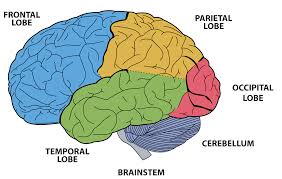
frontal lobe
Largest lobe of the cerebral cortex
Responsible for behavioral traits: personality, decision making, and motor control.
Makes sense of information about the environment, memories and emotions and uses this information to make decisions.
Fully develops around 25 years of age
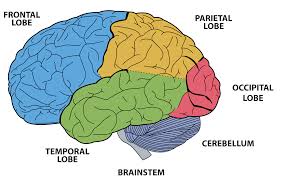
Parietal lobe
Integrates information from our sense to focus our attention on important things in the environment
Interprets sense of touch and monitors the body and its limbs
Receives signals from occipital lobe that reflects location of objects in our visual field
Left and right halves of the parietal lobe are generally responsible for information coming from respective sides of the body

Temporal lobe
Pairs the left and right sides of the brain
Manage emotions
Processing information from senses
Storing and retrieving memories
Understanding language
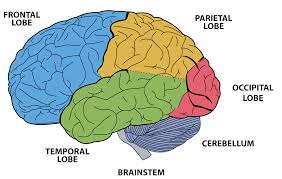
Occipital lobe
Visual processing area of the brain
Distance and depth perception
Colour determination
Object and face recognition
Memory formation
Visuospatial processing
The ability to tell where objects are in space, including your own body parts

Bronca Area
Small section of the left frontal lobe, behind the left eye
Key component of complex speech networks
The flow of sensory information from temporal cortex
Reaches maturity by 18 months
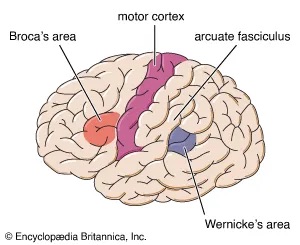
Wernicke’s area
Comprehends language both spoken and written
Reaches maturity by 18 months
Brain Plasticity
The capacity one has to learn and change. Neural networks in the brain grow and are reorganized/rewired.
As people age brain plasticity decreases, children have high brain plasticity, with higher capabilities to learn new things
An example of this is learning a new language, or playing a new instrument
Synaptic pruning
the removal of neurons and synapses it doesnt need. When an activity is unexercised
Language development rules: Phonology
the sound system of a language. A phoneme is the smallest sound unit in a language
The word chat has three phonemes or sounds /ch/a/t/
Language development rules: Morphology
the system of meaningful units involved in word formation of the smallest sound units
Ex. girl, has one sound unit and cannot b e broken down more, but when a suffix s is added, girls has two morphemes because the meaning of the word has changed
Language development rules: syntax
The system that involves the way words are combined to form acceptable phrases and sentences
The importance of word order, changing the meaning of the sentence
Ex. sebastian pushed the bike vs the bike pushed sebastian
Language development rules: semantics
the system that involves the meaning of words and sentences
Knowing the meaning of individual words such as the word orange, transportation or intelligent
Language development rules: pragmatics
the system of using appropriate conversation and knowledge of how to effectively use language in context
For example using the politie language in appropriate situations like being mannerly when speaking to a teacher or taking turns in conversations involves pragmatics
Stages of language development: early childhood
Can produce all vowel and consonant sounds (demonstrating knowledge of syntax, semantics and morphology)
Can use prepositions like “an”, “in”, “the”, “a”, “to be”
Vocab development very dramatic between 18 months-6 years due to fast mapping
Stages of language development: mid to late childhood
Increase of an average of 14,000 in grade 1 and increasing to 40,00 by grade 5
Develop metalinguistic awareness: knowledge about the language such as knowing what predispositions are or discussion sounds of language
the whole language approach
the phonics approach
Stages of language development: adolescence
Languages becomes more sophisticated due to more abstract thinking and analyzing the role words play in sentences
Understanding metaphors and satire
Improve at writing
Due to improved ability to organize ideas, can distinguish general vs specific points and can string together complex sentences
Stages of language development: adulthood and aging
Language development in adults is dependent on their education level, social interaction and occupation
Vocabulary is thought to increase in adulthood until one reaches older adulthood in which it is assumed to decline due to: difficulty understanding speech cause of hearing loss, poor health, loss in memory, etc.
Those with Alzheimer's experience difficulties finding words
what is fast mapping?
A child’s ability to make an initial connection between a word and its referent after limited exposure
The whole language approach
beginner readers are taught to recognize whole words or entire sentences, using context to guess the morning of words
The phonics approach
emphasizes teaching basic rules for translating written symbols into sounds (i.e. breaking down the sounds a word makes one phoneme at a time
Explicit memory
the conscious recollection of facts and experiences
Ex. Birth dates of friends and family members, Important events from your life, such as your wedding, a special trip, or another notable milestone.
implicit memory
memory without conscious recollection - memory of skills and routine procedures that are performed automatically.
Ex. singing a familiar song, typing on your computer keyboard, and brushing your teeth
short term memory
Involves retaining information for up to 30 seconds without rehearsing the information
With repetition & rehearsal, this strengthen in childhood
Ex. Remembering a person's name shortly after being introduced
working memory
Interacts w/ long term memory
Workbench where individuals manipulate information (decisions, problem solving) to eventually store it in long term memory
long term memory
Permanent type of memory that stores huge amounts of information for long periods of time
Becomes “autobiographical”, (remembering events through specific time and location)
Ex. Memory of how to ride a bike, important life events, etc
shallow processing
the encoding of information on basic auditory or visual levels, based on the sound, structure or appearance of a word
Ex. maybe you remember it by how it looked in a font or sounded
deep processing
the semantic encoding of information based on the actual meaning associated with the word, and is connected to something meaningful or related to a personal or emotional experience
Ex. learning about greek leonidas, associated with lions which are a symbol of strength
fluid intelligence
Being able to think and reason abstractly, solve problems, and generate/manipulate new information in real time.
Ex; problem solving skills, interpreting statistics, solving puzzles, use of critical thinking, etc.
crystallized intelligence
Refers to the accumulation of knowledge, facts, and skills that are acquired throughout one’s life and as they age.
Ex; memorizing text/vocab, recalling how to do something, remembering dates/locations, etc.
Garnder’s Theory of Multiple Intelligences
Howard Gardner argued people have multiple intelligences and proposed 8 different types;
He believed that Intelligence tests weren’t measuring all the different intelligences.
Verbal intelligence
Mathematical
Spatial intelligence
Musical
Interpersonal
Intrapersonal
Naturalist
Jean Piaget’s theory on specific stages of cognitive development
Children construct their own knowledge in response to their experiences
Children learn many things on their own without the intervention of older children or adults.
Children are intrinsically motivated to learn and do not need rewards from adults to motivate learning.
emotional regulation
the ability to control one's emotion (can be extreme (rage, happy, sad) or subtle (feeling uneasy)) and managing their responses to adapt to certain circumstances and reach a goal
emotion coaching
Something that parents do, and have a role teaching emotional regulation Emotional coaching monitors emotions and views negative emotions as a teaching opportunity. Parents help children label their emotions and help provide tips to deal with them
emotion dismissing
denying, ignoring or changing negative emotions
emotional intelligence
Ability to understand, use and manage your emotions
emotional competence
focuses on the adaptive nature of emotional experiences. Developing skills in social context, said skills develop throughout the life
what are the emotions in infancy
crying, smiling, fear
crying
is important for communication (first cry indicates lungs have air)
Basic cry, angry cry, and pain cry
smiling
Smiling key for developing social skills
Reflexive smile, and social smile
reflective smile
Does not occur in response to something and usually occurs during sleep
social smile
Occurs in response to an external stimuli (first 4-6 weeks) from caregivers voice
fear
one of the earliest emotions
stranger anxiety and separation anxiety
Emotional development: early childhood
Children begin to understand their emotions
Certain situations evoke specific emotions
Facial expression indicates emotions
Emotion affects others, and influences behaviour
Between ages 2-4 children increase the number to terms used to describe their emotions
By 4-5 they reflect on their emotions and understand an event can bring out different emotions for different people.
Emotional development: mid to late childhood
There are significant changes in this stage
Children improve emotional understanding
Meaning there is marked improvement in their ability to hide their negative emotional reactions
They use self regulation to redirect their feelings
Take deep breaths, drink water, take a walk, write about it, etc.
Larger tendency to look at the bigger picture during an emotional reaction
Develop capacity for genuine empathy for others
Emotional development: adolescence
Can be moody, with many reporting to be unhappy.
Moodiness is normal during this time
From puberty, hormones, transitioning into highschool, social media, bullying, etc.
But this can also be due to the brain itself, as our prefrontal cortex is not fully developed in order to control the fully developed parts of the brain that dictate emotions.
Meaning our emotions are fully developed but the control section of the brain
Emotional development: adulthood
Adults are motivated by their desire to create a satisfying lifestyle
These motivations influence their choices about life partners, careers, where they live, their peers and friends, while focusing on more emotionally meaningful goals
Emotional regulation is impacted by their ability to make the right decision in areas of their lives
Overall stronger control over their emotions
More balance and less intense highs and lows
socioemotional selectivity
socioemotional selectivity theory
Developed by laura carstensen, pertains to older adults
Her theory suggests that older adults become more selective about their activities and social relationships to maintain their emotional and social well being
Older people place higher values on emotional satisfaction, spending more time with comfortable people, who they feel happy around with stronger relationships
Narrowing off social interactions gives adults more positive emotional experiences and minimizes risks as they age
socialization (definition)
Socialization is a process that introduces people to social norms and customs. Helping individuals function in society, and in turn allowing society to run smoothly
Socialization: childhood
When people are very young they tend to relate to others from their own POV
Ideas are centered on you
Children are primarily concerned with their toys, their mom, their dad, their friends and home
When playing outside of the family, children begin to develop the ability to consider other viewpoints and upbringing
As children grow and develop their idea of relationships change from what they know at home to how to share relationships with others
Socialization in an individual's family lays the foundation for how a child is going to socialize and behave with others in their childhood stages
Their socialization or lack thereof can become very apparent
Children are learning to
Consider the thoughts and feelings of others
Beginning to develop social skills
Example: a child sharing a ball during recess and take turns jumping rope, lead them to already learning components of socialization in schooling
Socialization: adolescence
In teenage years adolescents continue to socially mature
They learn to “give and take” as they encounter different viewpoints
Adolescents use social skills as they develop close friendships of multiple genders and development throughout the lifetime
Meeting new people and new personalities comes into play at helping to understand others
By observing family members and interacting with the,, they learn how to respond to various life situations
People learn what's important, what guidelines to abide by and what actions are considered acceptable
Young people develop socially as they adopt these beliefs and standards as their own
Part of their socialization process includes thinking about and questioning parents standards
By they provide answers and reasons for their standards and beliefs
Parents can help children understand their future roles
Socialization: adulthood
The adult stage of socialization relies on the interactions and experiences throughout various aspects of one’s life: friendship, partners, work life, home life, parenting, home/apartment/condo ownership
Workplace culture is very different from parenting culture, hence why adult’s have to be ready to change their past experiences of socialization.
A marker of success in socialization in adulthood relies on their ability to adapt and interact with various groups
Successful development in childhood and adolescence is needed for this to happen
If early on socialization development is stunted, it is visible in adulthood
Socialization: old age
People who are older their opportunity for socialization lessens as individuals can't rely on previous environments to be a part of a group or community
There is a large loss of relationships including friendships, from work, from the disness and health decline of friends and family (passing away), as well as loved ones moving away, or older person is moved away if they are unable to take care of themselves
Communities and groups for older groups exist for recreation center programs, exercise classes, bingo games, and social events, which encourage and promote new forms of socialization
Socialization in old age is possible and incredibly beneficial for individuals who are missing a sense of belonging and community in the ways they were earlier throughout their lives
How might socialization look in childhood vs adulthood vs late adulthood?
Socialization in childhood is mostly through caregivers, teachers, peers and overall authority figures, maybe from sports, school, religious institutions, etc.
In adulthood socialization may occur is based more in work, friendships, home life, becoming a parent and gaining more responsibilities like owning a home
In late adulthood towards older age there is less people interacting with one another, the relationships from adolescence and adulthood tend to dwindle and there are less experiences of socialization
primary socialization
birth through adolescence.
Being guided by caregivers, teachers, coaches, religious figures, and peers
secondary socialization
adolescence and onwards.
Takes places in situations and experiences that are part of our primary socialization. Instilling new norms, values, and behaviors as individuals interact with different groups and people.
Being guided from post-secondary schooling experiences, travel, friend groups, job opportunities and overall new experiences.
organizational socialization
Found specifically within institutions or organizations
In this process an individual becomes socialized to the norms, values and practices of the institution/organization
Being guided from workplaces, schools, government, etc.
socioeconomic status (definition)
ones perceived social standing with complex factors that involve access to and quality of education, income, financial security, occupation, living conditions, resources, opportunities, etc.
Chess and Thomas Classification
Involves individual differences in behavioral styles, emotions and characteristic ways in responding to certain situations
Refers to how quickly emotion is shown, how strong it is, how long it lasts, and how soon it fades away
Psychiatrists Alexander Chess and Stella Thomas identified 3 basic types of temperament
easy child, difficult child, slow-to-warm-up child
Easy child
Part of chess and Thomas classification for temper
Generally positive, quickly establishes regular routine in infancy, and adapts easily to new experiences (40% of children)